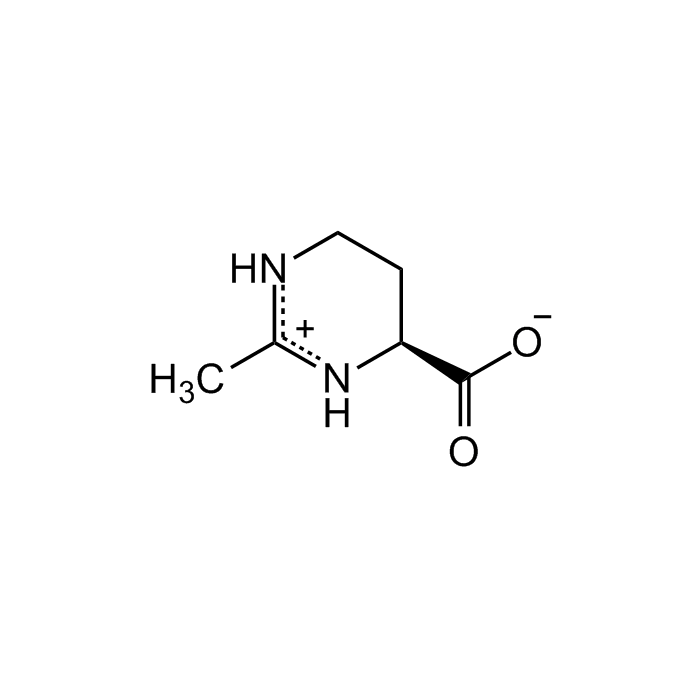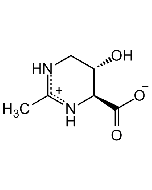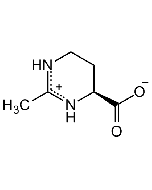Cookie Policy: This site uses cookies to improve your experience. You can find out more about our use of cookies in our Privacy Policy. By continuing to browse this site you agree to our use of cookies.
AdipoGen Life Sciences
Ectoine (ultrapure)
As low as
CHF 0.00
In stock
Only %1 left
AG-CN2-0391-G0011 gCHF 158.00
AG-CN2-0391-G01010 gCHF 868.00
AG-CN2-0391-G100100 gCHF 5’333.00
AG-CN2-0391-GT011000 gINQ

Relative increase of membrane stability of erythrocytes using ectoine.
Ectoine inhibits the aggregation of lactate dehydrogenase (LDH). Increase of turbidity through aggregation at 50°C of LDH is measured at 620nm.
Stabilization of antibodies during freeze-thaw cycles using hydroxyectoine in the buffer.
Hydroxyectoine is an efficient stabilizer during lyophilization of proteins. The example shows lactate dehydrogenase and phosphofructokinase, 80 % of activity is retained when 1 M Hydroxyectoine has been added prior to lyophilization.
| Product Details | |
|---|---|
| Synonyms | Ectoin; (S)-2-Methyl-4-carboxyl-1,4,5,6-tetrahydropyridine; Pyrostatine B |
| Product Type | Chemical |
| Properties | |
| Formula |
C6H10N2O2 |
| MW | 142.2 |
| CAS | 96702-03-3 |
| Source/Host Chemicals | Isolated from halophilic bacteria Halomonas elongata. |
| Purity Chemicals | ≥99% (HPLC) |
| Appearance | White solid. |
| Solubility | Soluble in water (560mg/ml) or methanol (40mg/ml). |
| Identity | Determined by 1H-NMR. |
| Declaration | Manufactured by bitop AG, Dortmund/Germany. |
| InChi Key | IUIXWYFDVVGMRU-YFKPBYRVSA-M |
| Smiles | C[c+]1[nH][C@H](C([O-])=O)CC[nH]1 |
| Shipping and Handling | |
| Shipping | AMBIENT |
| Short Term Storage | +4°C |
| Long Term Storage | +4°C |
| Handling Advice |
Hygroscopic. Keep cool and dry. Protect from moisture. |
| Use/Stability | Stable for at least 2 years after receipt when stored at +4°C. |
| Documents | |
| MSDS |
 Download PDF Download PDF |
| Product Specification Sheet | |
| Datasheet |
 Download PDF Download PDF |
Description
- The ectoines belong to the class of compatible solutes also called extremolytes (osmolytes from extremophiles). Extremolytes stabilize biological structures and macromolecules such as lipid membranes and proteins against a variety of stress factors, including high temperature, freeze-thaw cycles, drying and degradation. These very stable, non-toxic, animal-free protective agents are powerful additives in various Life Science applications, ranging from cryoprotection of animal cells over protein storage to PCR. They are protective osmolytes selected by nature for stabilization of all proteins in the cell against denaturing environmental stress without altering their functional activity. The stabilizing effect is based on the fact, that the protective osmolytes are strong water-structure formers and as such are preferentially excluded from the protein surface. This causes an increased water density at the surface ("preferential hydration") promoting the protein’s natural conformation with hydrophobic patches buried. This reduces the potential to unfold in response to physical or chemical stress and enhances the stability of the protein. Therefore, these compounds have also been termed chemical chaperones. Several studies have demonstrated the ability of extremolytes to also stabilize cell membranes and whole cells. Therefore, the extremolytes are also useful additives for the cold storage and cryostabilization of mammalian and bacterial cells.
- Ectoines are the best characterized extremolytes and their ability to stabilize a variety of proteins, nucleic acids, membranes and whole cells is well documented. They surpass the efficiency of common compatible solutes like betaine and trehalose in applications like protein stabilization and stabilization of desiccated bacterial cells. The ectoines are highly water-soluble, zwitterionic low-molecular weight molecules, chemically and physically stable, biologically inert and compatible with most enzymatic and binding reactions (intracellular concentrations in their producer organisms can exceed 1 M).
- Ectoines can be used in a wide range of applications for the protection and stabilization of biological macromolecules and whole cells, animal as well as bacterial. Ectoines protect and stabilize proteins, especially globular proteins like antibodies, in vitro and in vivo and provide an integrated solution for the optimization of protein production. They are protein-free low molecular weight additives that can be used to, i) culture media to increase the stability and solubility of expressed proteins, ii) prevent protein aggregation and proteolytic degradation during downstream processing in solutions, iii) assist in refolding of inclusion bodies in refolding buffers, iv) prevent the loss of activity due to freeze-thawing, lyophilization and damage (aggregation, proteolysis) during storage in solution, v) promote crystal formation vs. protein aggregation and to improve crystal size and quality during crystallization of proteins.
- Next to its stabilizing effects, ectoines show cell protective, antioxidant, neuroprotective and anti-inflammatory mode of actions that have been verified in various in vitro and in vivo studies and include protection of lipid membrane, radical-scavenging activity and protection against UVA or oxidative stress. Ectoines have protective (e.g. UV-A radiation) and destabilizing effects on dsDNA, depending on the concentration. At high ectoine concentration (2.5 M), direct interactions between compatible solute and DNA molecules are possible and provides new perspectives for biotechnical applications. Ectoine is already in use for in vitro diagnostics as an enhancer for PCR. Therefore, this molecule would be a promising candidate in facilitating isothermal DNA amplification such as recombinase polymerase amplification. In-house studies have shown that ectoine inhibits the binding of the spike protein of COVID-19 virus to lung cells.
Product References
- 1,4,5,6-Tetrahydro-2-methyl-4-pyrimidinecarboxylic acid. A novel cyclic amino acid from halophilic phototrophic bacteria of the genus Ectothiorhodospira: E.A. Galinski, et al.; Eur. J. Biochem. 149, 135 (1985)
- The protective function of compatible solute ectoin on the skin cells and its biomolecules with respect to UV-ratiation, immunosupression and membrane damage: J. Bunger, et al.; IFSCC Magazine 4, 1 (2001)
- Ectoin: an effective natural substance to prevent UVA-induced premature photoaging: J. Bunger & H. Driller; Skin Pharmacol. Physiol. 17, 232 (2004)
- Characterization of the synthetic compatible solute homoectoine as a potent PCR enhancer: M. Schnoor, et al.; BBRC 322, 867 (2004)
- Ectoine and hydroxyectoine inhibit aggregation and neurotoxicity of Alzheimer's beta-amyloid: M. Kanapathipillai, et al.; FEBS Lett. 579, 4775 (2005)
- Ectoine from halophilic microorganisms induces the expression of hsp70 and hsp70B' in human keratinocytes modulating the proinflammatory response: E. Buommino, et al.; Cell Stress Chaperones 10, 197 (2005)
- The multifunctional role of ectoine as a natural cell protectant: R. Graf, et al.; Clin. Dermatol. 26, 326 (2008)
- The compatible solute ectoine protects against nanoparticle-induced neutrophilic lung inflammation: U. Sydlik, et al.; Am. J. Respir. Crit. Care Med. 180, 29 (2009)
- The effect of compatible solute ectoines on the structural organisation of lipid monolayer and bilayer membranes: R.K. Harishchandra, et al.; Biophys. Chem. 150, 37 (2010)
- Recovery of neutrophil apoptosis by ectoine: a new strategy against lung inflammation: U. Sydlik, et al.; Eur. Respir. J. 41, 433 (2013)
- Bacteria-Derived Compatible Solutes Ectoine and 5α-Hydroxyectoine Act as Intestinal Barrier Stabilizers to Ameliorate Experimental Inflammatory Bowel Disease: H. Abdel-Aziz, et al.; J. Nat. Prod. 78, 1309 (2015)
- Ectoine protects DNA from damage by ionizing radiation: M.-A. Schroter, et al.; Sci. Rep. 7, 15272 (2017)
- Role of the Extremolytes Ectoine and Hydroxyectoine as Stress Protectants and Nutrients: Genetics, Phylogenomics, Biochemistry, and Structural Analysis: L. Czech, et al.; Genes 9, 177 (2018)
- Stabilization of dry protein coatings with compatible solutes: M.S. Killian, et al.; Biointerphases 13, 06E401 (2018)
- Hydration in aqueous solutions of ectoine and hydroxyectoine: C.J. Sahle, et al.; Phys. Chem. Chem. Phys. 20, 27917 (2018)
- Hydroxyl radical scavenging of the compatible solute ectoine generates two N-acetimides: S. Brands, et al.; Arch. Biochem. Biophys. 674, 108097 (2019)
- The Skin-Whitening Effects of Ectoine via the Suppression of α-MSH-Stimulated Melanogenesis and the Activation of Antioxidant Nrf2 Pathways in UVA-Irradiated Keratinocytes: Y.-C. Hseu, et al.; Antioxidants 9, 63 (2020)
- Protective effect of the extremolytes ectoine and hydroxyectoine in a porcine organ culture: T. Tsai, et al.; Graefes Arch. Clin. Exp. Ophthalmol. 258, 2185 (2020)
- Ectoine and Hydroxyectoine Stabilize Antibodies in Spray-Dried Formulations at Elevated Temperature and during a Freeze/Thaw Process: P.K. Nayak, et al.; Mol. Pharm. 17, 3291 (2020)
- What Does Ectoine Do to DNA? A Molecular-Scale Picture of Compatible Solute-Biopolymer Interactions: J. Wittmar, et al.; J. Phys. Chem. B 124, 7999 (2020)
- The ups and downs of ectoine: structural enzymology of a major microbial stress protectant and versatile nutrient: L. Hermann, et al.; Biol. Chem. 401, 1443 (2020)








